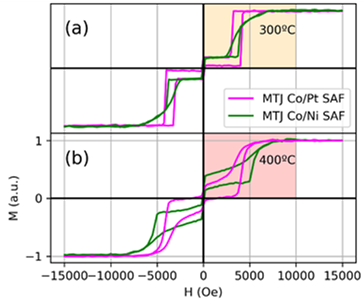Perpendicular anisotropy Magnetic Random Access Memory (MRAM) can contribute reduced power consumption in electronic circuits. These spintronic devices also rely on materials like Co, Pt and Ru, having associated supply risk or environmental impact. A sustainability analysis of these devices shows, that the impact of the wafer substrate is much larger than that of the devices materials themselves. This is due to the small material quantity used and target recycling measures. A substitution of Pt/Co by Ni/Co multilayers can also contribute to a 3x reduction of the global warming potential (GWP).

Substitution of Co/Pt by Co/Ni multilayers in the reference layer of MRAM confirms equivalent annealing and thermal stability.
Use of MRAM in the fields of IoT (Internet of Things) and generally in information and communication technology (ICT) is expected to significantly increase bringing non-volatility and low power consumption to these applications. Supply risk, was evaluated considering recycling, substitution and supply concentration. Our analysis concludes that platinum is the element that poses the most significant risk, taking into account the amount of material that is used in the stack. Our investigation also confirms that due to the tiny amounts of material only 3.4 milligrams of Pt used, economic and environmental costs are dominated by the production of the substrate wafer itself, corresponding to 127 grams of Si.
The highest motivation to consider Pt substitution is disruption supply risk, with 80% of world production concentrated in two countries South Africa and Russia. An alternative to Pt is the replacement of the Co/Pt multilayer in the reference layer by a Co/Ni multilayer. Ni having no scarcity or supply disruption risks. Results show that the thermal stability reference electrode base on a multilayer of [Co 0.5 nm/Pt 0.25 nm] can be replaced by a [Co 0.18 nm/Ni 0.55 nm] multilayer, achieving the same magnetic and annealing stability, as shown in the figure. Copper was used as seed layer with Ni, without requiring other critical materials. The global warming potential of the Ni reference layer is reduced by a factor of 3, compared to the Pt alternative.
Finally, other possible material concerns were evaluated as not significant because of the small quantities used, as is the case for Mg in the MgO tunnel barrier, or for W used as 0.2 nm thin insertion layers acting as a boron getter in typical MRAM stacks. In conclusion, wider adoption of MRAM technology by the electronics industry can be envisioned in a sustainable way, with credible substitutions available to prevent risks in critical materials.
Teams: MRAM
Collaboration: Laboratoire CERAG Université Grenoble Alpes
Funding: French National Research Agency “Investissements d’avenir” program (ANR-15-IDEX-02) and project NEED for IoT by the University of Grenoble Alpes (UGA)
Further reading: Evaluating critical metals contained in spintronic memory with a particular focus on Pt substitution for improved sustainability, A. Palomino, J. Marty, S. Auffret, I. Joumard, R. C. Sousa, I.L. Prejbeanu, B. Ageron and B. Dieny, Sustainable Materials and Technologies 28, e00270 (2021).
Contacts: Ricardo Sousa




